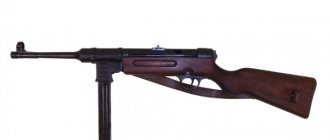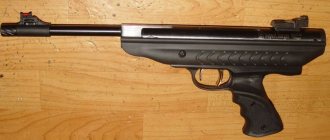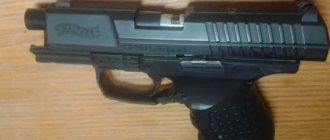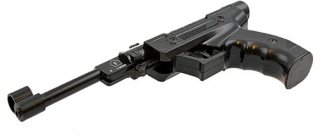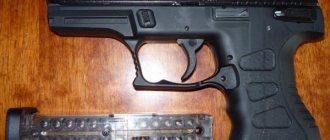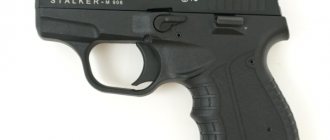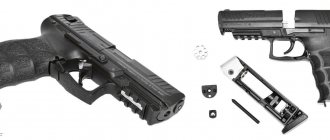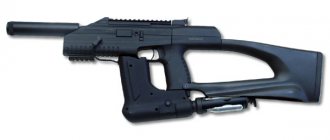Review of the ASG Bersa Thunder 9 Pro air pistol
This pistol was made in Taiwan, at one of the factories owned by a Danish company. Visually, the manufacturer has achieved excellent resemblance to the original, nothing to say. But almost all the distinctive details (trigger, bolt, bolt stop) are just an entourage. They do not play a functional role, since they are motionless and are made together with a molded plastic body. The smooth barrel, made of metal, allows you to shoot only steel balls.
Due to the plastic, the air pistol is very light - a little more than half a kilo. Its handle is very comfortable and pleasant to hold in the palm of your hand. The shooting results are quite decent: both in accuracy and accuracy.
The gas canister inserted into the handle is used sparingly. It is enough for a hundred shots, and often for more.
Advantages and disadvantages
Advantages of the ASG Bersa Thunder 9 Pro air rifle:
- Great resemblance to the original.
- All parts are well processed, the plastic is durable and shock-resistant, the assembly is of high quality.
- The ergonomics of the handle are excellent.
- The price is budget.
- Economical consumption of CO2 from a cylinder.
- Highly visible aiming devices.
Disadvantages of the model:
- Plastic housing.
- No moving elements (except for the safety and release hook).
- Specifics of the device that feeds the balls. If you don't press the trigger all the way and accidentally tilt the barrel, the ball will fall out.
- The magazine is not full-size; its heel is made of plastic.
- The descent is long and quite difficult.
Photo of the ASG Bersa Thunder 9 Pro air pistol
Possibility of use
An economical and unpretentious model can be suitable as a first gas pistol. It will appeal to those for whom realistic shutter movement and metal on the body are not so important, but who value lightness, convenience and accuracy. Entertainment, training and mastering weapon handling skills - all this can be provided by an inexpensive pistol.
History of development[edit]
This pistol is a development of the Model 90, the first full-size 9mm Luger pistol manufactured by the Argentine company and introduced in 1989. In 1994, when the entire Bersa pistol product line was renamed "Thunder", the Model 90 was modified with improved functionality and fire control group placement, a match barrel, improved sights, better ergonomics, lighter weight and increased magazine capacity. It then became a full-size offering in the Thunder range. [1]
Specifications
| Characteristics | Indicators | Unit measurements |
| Type | gas cylinder | |
| Frame | made of impact-resistant plastic | |
| Type of trigger mechanism | double | |
| Type of charges | metal balls type BB | |
| Caliber | 4,5 | mm |
| Sharikov in a full clip | 19 | PC. |
| Weight | 530 | G |
| Smooth barrel length | 11,5 | cm |
| Gun length | 19,2 | cm |
| CO2 canisters are used for firing | 12 | G |
| Energy (muzzle) | less than 2.6 | J |
| Speed of the flying ball | 122 | m/s |
| The can is enough for | 100 | shots |
Links[edit]
- Rees, Clair (2015-11-23). "Pistol Review: Bersa Thunder Pro Ultra Compact in 9mm". The World of Personal Protection
. Retrieved September 6, 2016. Measuring 6.5 inches long and weighing 23 ounces, this is not a miniature firearm. It is larger and heavier than many of the 9mm "pocket pistols" on the market. - ".: Bersa Thunder Series:. Fuerzas Armadas y de Seguridad". web.archive.org
. 2012-04-01. Retrieved October 10, 2022. - Infodefensa.com (2017-05-19). "Bersa Vende 10.000 pistoles al Ejército de Bangladesh - Noticias Infodefensa América". Infodefensa.com
(in Spanish). Retrieved October 10, 2022.
Device
The molded plastic halves include a simulated hammer, bolt and slide stop. Inside the false barrel there is a smooth metal barrel - it is movable. The trigger is double, allowing only self-cocking to be used for shooting. The release hook goes about 17 millimeters freely, then (2 millimeters) - more tightly. It is during the short stroke that the mechanism operates.
The fuse in the form of a lever is located on the right side of the case. Having moved it to the forward position, you cannot shoot. In the rear position, the weapon is ready for use.
The plate magazine, inserted into the handle from below, is entirely (except for the heel) made of metal. The balls are poured directly into the hole in the magazine body.
Neither the front sight nor the rear sight can be adjusted. They, like the rest of the body parts, are plastic. But they are distinguished by good contrast and visibility in the twilight - thanks to the painted large white dots. Additionally, a Picatinny rail is provided under the barrel.
Operating principle
We move the linings on the handles back and up, making room for the cylinder. It is secured with a thumbscrew hidden there for tightening - a separate hexagon is not required. Then all the parts are put in place and the store is equipped. The balls are placed into it from below. To do this, the feeder spring is retracted. After charging, it returns to its original location with a button on the magazine heel.
The trigger must be pressed (not too sharply) and not released until the ball leaves the barrel (remember the peculiarities of equipping the pistol with charges). In this case, when the trigger is triggered, a valve opens, allowing a portion of CO2 to escape. The energy of the compressed gas is enough to accelerate the ball.
The video shows a pneumatic copy of Thunder 9 Pro in action:
Disassembly
First, let's prepare a slotted screwdriver, an awl and a clock-type screwdriver (which can be replaced with a screwdriver with a rod of 1.5 to 2 millimeters).
We put the fuse in position “F”. Having pulled out the magazine, we take out the gas canister by sliding it to the rear position and lifting the back of the handle, and then removing it completely.
To carry out further disassembly, carefully squeeze out (always from right to left) the pins that connect the plastic molding parts. They are located at the rear and front of the frame, at the rear of the bolt.
After this, it will be possible to remove the fixed bolt, as well as the trigger mechanism and the movable metal barrel with a spring.
Diagram of the ASG Bersa Thunder 9 Pro pistol
Pistol Bersa M 90 / Thunder 9 / Thunder 40 / Thunder 45
| Bersa Mod 90 |
In 1989, continuing the production of compact pistols, it developed its first full-size combat pistol with a double-action trigger - the Bersa Mod 90 chambered for 9 mm Parabellum.
In 1994, Bersa introduced a new name for all its newly released pistols - “Thunder”, where after the name a number was installed indicating the caliber of the weapon. At the same time, a new pistol went into production - Thunder 9, which is an improved version of the Bersa M 90.
The Bersa Thunder 9 pistol, being a modification of the 90th model, had a similar design, shape and dimensions, with the exception of certain changes. So the designers moved the safety lever from the left side of the bolt casing to the frame, duplicating it on the other side, added an indicator for the presence of a cartridge in the chamber, and used new sighting devices. In addition, the shape of the trigger and individual controls were changed. In general, the Thunder 9 pistol has improved ergonomics and ease of use compared to its predecessor.
| Bersa Thunder 9 (above - an early model, the lack of guides on the frame is clearly visible; the protrusion is not on the back surface of the trigger, but on the frame; old sights are used) |
The automatic weapon operates according to the scheme of using recoil with a short barrel stroke. Locking is carried out using the lowering breech of the barrel, which enters with its rectangular protrusion located above the chamber into the window for ejecting spent cartridges of the bolt-casing. The reduction occurs when the bevel of the lower tide of the barrel breech interacts with the protrusion of the frame.
The frame and bolt casing are made of weapon steel.
The shutter-casing has an inclined notch in the rear part and a narrowing in the front part, which makes it convenient to hold it when moving it back.
In the upper part of the bolt casing, behind the hole for ejecting spent cartridges, there is an indicator of the presence of a cartridge in the chamber. It is made in the form of a lever that protrudes beyond the upper edge of the bolt-casing if there is a cartridge in the chamber of the barrel. The side surfaces of the pointer have red marks. As a result, the shooter can check whether the weapon is loaded at any time (even in the dark or in his pocket by touch).
| Bersa Thunder 9 on slide stop |
The trigger mechanism is hammer-type, double-action, with safety cocking.
On the back surface of the trigger there is a protrusion that serves as a travel limiter, which eliminated the failure of the trigger after the trigger was decocked from the sear and increased the shooting accuracy. On early models, this protrusion was made on the frame.
The trigger has a large loop-shaped head with a notch.
On the sides of the rear part of the frame there are levers for a double-sided safety lever. When it is turned on, the hammer is safely released from cocking, the sear and the bolt-casing are blocked. Safety in handling is also ensured by the automatic firing pin safety.
The slide stop release levers are also duplicated on both sides of the frame and placed in front of the safety levers.
On the left side of the frame, above the trigger, there is a barrel lock lever.
The Bersa Thunder 9 pistol is fed from a detachable box magazine with a staggered arrangement of 17 rounds in two rows. The push-button magazine release, located at the base of the trigger guard, can be easily reinstalled on the right side of the frame.
| Bersa Thunder 9 |
Open-type sighting devices consist of a front sight, manufactured integrally with the bolt casing, and a rear sight inserted into the transverse groove of the dovetail casing.
The enlarged trigger guard and the recess on its front wall allow you to fire with gloves and with both hands.
On the frame under the barrel there are guides for attaching various devices, such as a laser designator, a flashlight, etc. (on early models there were no guides).
The plastic cheeks of the wrap-around type handle with a recess for the thumb have a cross diamond-shaped notch on the side surfaces and a notch on the back surface.
In 1997, it began producing the Bersa Thunder 40 pistol, created on the basis of the Thunder 9 model and differing only in the cartridge used - .40 S&W and a reduced magazine capacity with a staggered arrangement of 13 rounds in two rows.
| Bersa Thunder 40 |
In the late 1990s, compact models of Thunder pistols were offered, designated the Mini Thunder 9 and Mini Thunder 40. The Bersa Mini Thunder 9 and Mini Thunder 40 pistols differed from the full-size Bersa Thunder 9 and Thunder 40 models by having a reduced barrel length and magazine capacity, respectively. and overall dimensions, as well as grooves for fingers in the front surface of the handle and a protrusion of the magazine cover for better retention of the weapon. In addition, compact pistols began to be equipped, as another safety feature, with a mechanical trigger lock, which has two positions - F or S (in position S the safety is turned on, which is difficult to turn off without a key).
| Bersa Mini Thunder 9 (top) and Mini Thunder 45 (bottom) |
In addition to compact models in 9mm and .40 S&W, Bersa also began producing a pistol chambered in .45 ACP, designated the Mini Thunder 45, which soon became one of the most popular compact pistols. The Mini Thunder 45 pistol is similar in design to previous models and differs in magazine capacity with 7 rounds arranged in one row and overall dimensions due to the use of a larger .45 ACP cartridge.
Soon the original names of the compact pistols Mini Thunder 9, Mini Thunder 40 and Mini Thunder 45 were changed to Thunder 9 Ultra Compact, Thunder 40 Ultra Compact and Thunder 45 Ultra Compact respectively.
| Bersa Thunder 9 Ultra Compact |
In the 2000s, Bersa's Thunder 9/Thunder 40/Thunder 45 line of pistols were improved with the use of a universal Picatinny rail at the front of the frame under the barrel (for mounting additional accessories, such as a tactical flashlight or laser designator) and new sights . The improved models received new names accordingly:
- Thunder 9 Pro.
- Thunder 40 Pro.
- Thunder 9 Ultra Compact Pro.
- Thunder 40 Ultra Compact Pro.
- Thunder 45 Ultra Compact Pro.
| Thunder 9 | Thunder 40 | Mini Thunder 9 | Mini Thunder 40 | Mini Thunder 45 | |
| Caliber, mm | 9x19 | .40 S&W | 9x19 | .40 S&W | .45 ACP |
| Length, mm | 192 | 192 | 165 | 165 | 170 |
| Barrel length, mm | 110 | 110 | 89 | 89 | 92 |
| Weight without cartridges, kg | 0.794 | 0.794 | 0.695 | 0.695 | 0.766 |
| Store, count. cartridges | 17 | 13 | 13 | 10 | 7 |
In general, Bersa pistols of the Thunder 9, Thunder 40, Thunder 45 series have proven themselves to be the best, having a very good combination of combat and service qualities with a very reasonable price.
This weapon has good manufacturing quality and surface treatment, shooting accuracy and reliability. Moreover, its cost is much cheaper than pistols with similar performance characteristics produced in the USA and Western European countries. This combination of price and quality determined the success of pistols. In Latin America and the United States, Bersa pistols began to be purchased mainly for self-defense, and the Thunder 9 model was adopted by the Argentine armed forces, the federal police and the Buenos Aires police department. In addition, Argentine shooters from the BersaTeam won several IPSC matches with Thunder pistols.
| Thunder 9 Pro, Thunder 40 Pro, Thunder 9 Ultra Compact Pro, Thunder 40 Ultra Compact Pro, Thunder 45 Ultra Compact Pro (top to bottom) |
Finalization
In terms of tuning, gas-type Bersa Thunder 9 models respect barrel extensions, starting to shoot faster and more powerfully. But due to the fact that the body is made of plastic, you won’t have much success in this matter. Otherwise it can tear the plastic. However, a little lengthening of the stem won't hurt. To do this, it is enough to adapt a piece of a suitable metal tube.
Now about the valve mechanism, or rather, about the problems that may arise with it. After firing several thousand shots, you can sometimes notice that the gas in the can begins to leave too quickly (sometimes all of it almost immediately). This indicates wear of the valve gasket. Replacing it fixes the problem. If you don’t have a new gasket at hand, you can try turning the old one over - it will help for a while.
If the valve gasket is simply wrinkled and lost its shape, but there is no damage on it, craftsmen advise soaking it in silicone for a day. The form is restored.
And one more thing: you should not store the gun for a long time with a loaded can. And before installing a new cylinder, each time it is recommended to lubricate its neck with silicone lubricant. This will prevent leaks.
Options [edit]
From the original Thunder 9, many other versions were later introduced.
Calibers[edit]
The number after the name "Thunder" identifies the cartridge fired. They are called Thunder 9, Thunder 40 and Thunder 45 for the 9mm Luger, .40 S&W and .45 ACP cartridges respectively. The Thunder 9 and Thunder 45 Ultra Compact are rated +P.
Compact versions[edit]
Compact versions of the full-size Bersa Thunder pistols were introduced in the late 1990s. The name was originally "Mini Thunder", later changed to "Thunder Ultra Compact". Available cartridges: 9mm Parabellum, .40 S&W and .45 ACP. The .45 version is not available for the full size pistol. Barrel length reduced to 3.25 inches (3.6 for .45 ACP).
The Thunder Ultra Compact is equipped with a safety key to activate the safety interlock system located on the left side of the frame under the release lever, in the locked position the hammer cannot be cocked, the trigger will not operate in double action, the bolt will not operate, and the pistol cannot be disassembled . Each pistol has an individual key.
